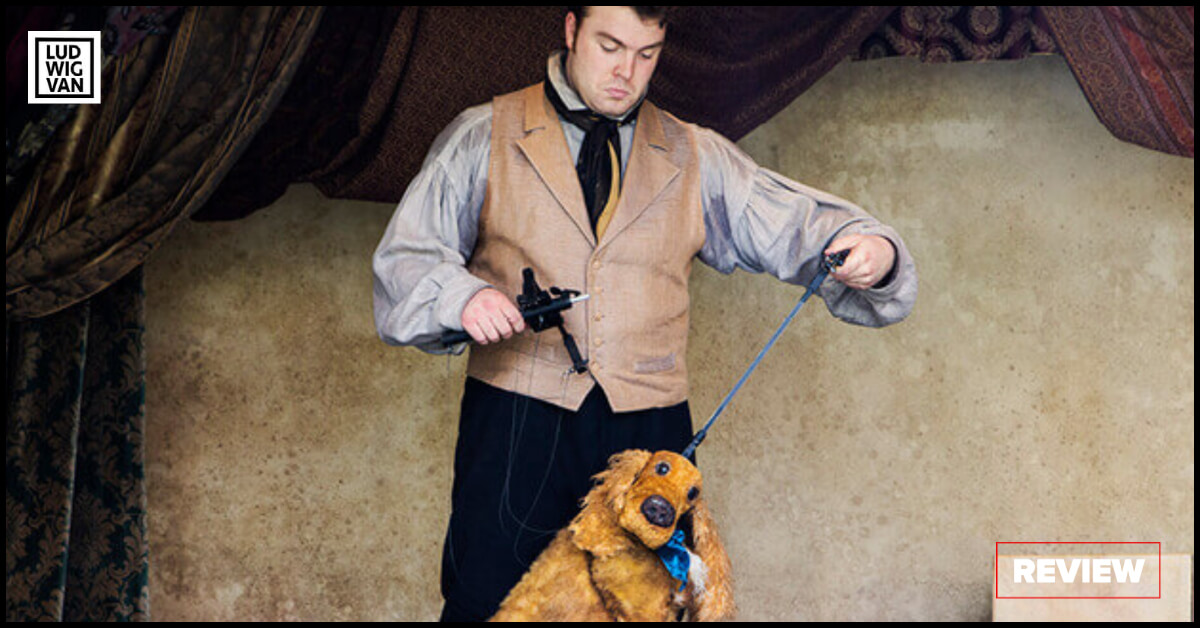
Shaw Festival/Flush, adapted from Virginia Woolf’s Flush: A Biography and directed by Tim Carroll, Royal George Theatre, Niagara-on-the-Lake, Aug. 17 to Oct. 2.
The Shaw Festival’s lunchtime production of Flush, is, for lack of a better word, cute. There is nothing more endearing, after all, than a lovable puppet. This does not mean, however, that Flush is without substance.
Virginia Woolf wrote the novella Flush: A Biography in 1933, and the premise is fascinating. Using her trademark stream of consciousness technique, so evident in her revered novels, Woolf enters into the psychology of her central hero who is, surprisingly, poet Elizabeth Barrett Browning’s cocker spaniel.
Whether for Flush, or one of Woolf’s notable heroines like Mrs. Dalloway, the author uses the interior monologue, as it were, to reference issues such as class distinctions, Victorian mores, patriarchal society, female oppression, and rising fascism. I, for one, have never accepted Flush: A Biography as a Woolf lesser vessel. It might be an easier read than the novels, but the novella contains great insights. Flush himself is a brilliant character study.
Because Flush happens to belong to Elizabeth Barrett, we also witness the growing love between Miss Barrett (as Flush thinks of her) and fellow poet, Mr. Robert Browning (of whom Flush is initially jealous). We watch, along with Flush, as the invalid Elizabeth gains health and strength through this famous 19th century love story, and is finally able to escape her tyrannical father for the freedom of marriage and Italy.
Apparently, Woolf became fascinated by Flush through the many times he is mentioned in the published Barrett/Browning correspondence. As well as the letters, the author also found inspiration in the two poems Barrett wrote about her beloved cocker spaniel, To Flush, My Dog and Flush or Faunus.
The concept behind the production is quite imaginative. Flush is a puppet, or I should say several puppets, covering the dog as he grows to adulthood. Designer Hanne Loosen has created a little theatre with divided curtains that can raise either altogether or separately. Behind the curtain, we see tableaux, just bodies but never faces of the actors, as they enact various scenes from Barrett’s (and Flush’s) life.
Nothing is hidden. We see Flush on strings being manipulated by actor Drew Plummer, and it is really quite adorable how the puppet is able to convey both body language and facial expression. Alexandra Montagnese is credited with creating the puppet and kudos to her for Flush’s many moving parts.
Director Tim Carroll, who also happens to be artistic director of the Shaw Festival, adapted the novella by using Woolf’s own words which are spoken by narrators, These actors come and go to stand on either side of the little stage where they recite the narrative. They also depict the characters in the story: Elizabeth Barrett (Julie Lumsden), Robert Browning (Jonathan Tan), the Barretts’ Maid (Jacqueline Thair), and the aforementioned Plummer. The actors are dressed in black vests and pants so they can easily slip in and out of wigs and costumes as needed.
Now I do have one complaint. You could hear Thair and Plummer quite clearly when they spoke, but Lumsden and Tan tended to drop their voices at the end of lines which made for a projection problem. Since these two carry the bulk of the narration, they have to speak up. I’m also not sure that the faux-English accents are necessary because they are uneven at best.
Carroll has done very well with what he chose to include in the text for this hour-long show. He begins with the history of the cocker spaniel breed and the assurity of Flush’s pedigree, (The dog is, in fact, a snob.), The narrative takes us through Flush’s beginnings in the English countryside at the home of his breeder, Mary Russell Mitford, a fellow writer and friend of Barrett’s, who gives her the dog as a gift.
From a country dog, Flush becomes a city dog and we become privy to his observations in the big house on Wimpole Street. When Barrett makes her great escape, she takes the dog with her, and Flush’s life in Italy is, like Barrett’s, also finding freedom. The charm of the narrative as a whole is the relationship between Barrett and Flush.
Perhaps the most notable aspect of this production is that the text never detracts from Woolf’s writing in all its cleverness. Because the words are Woolf’s, and the insights she chooses to give to Flush are authentically hers, the heart of the novella is intact, The puppet show augments Woolf’s narrative, and the visual and aural work together in seamless fashion. Admittedly, the format of the narrators suddenly appearing and speaking the text does become a bit repetitive, but the weight of Woolf’s words is more important, and we accept the theatrical structure.
And one last thing. The music which plays between scenes is Mendelssohn’s incidental music for Shakespeare’s A Midsummer Night’s Dream, and its very whimsical quality works well with both the quirky nature of the production, and the whole fantastical notion of life as seen through the eyes of a dog.
Trust me when I tell you that Flush will become almost a human person before the end of the play, and you will accept his adventures as absolute reality.
#LUDWIGVAN
Get the daily arts news straight to your inbox.
Sign up for the Ludwig van Daily — classical music and opera in five minutes or less HERE.
- INTERVIEW | Actor Diego Matamoros Takes On Icon Walt Disney In Soulpepper Production Of Hnath Play - April 16, 2024
- SCRUTINY | Opera In Concert Shine A Light On Verdi’s Seldom Heard La Battaglia Di Legnano - April 9, 2024
- SCRUTINY | Lepage & Côté’s Hamlet Dazzles With Dance And Stagecraft Without Saying Anything New - April 5, 2024



